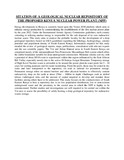| dc.description.abstract | Energy development in Kenya is currently based upon the Vision 2030 platform which aims to
enhance energy production by commissioning the establishment of the first nuclear power plant
by the year 2022. Under the International Atomic Agency Commission guidelines, each country
venturing or utilizing nuclear energy is responsible for the safe disposal of its own radioactive
nuclear waste. This study aims to analyze the probable locality for the development of a deep
geological repository based on IAEA guidelines regarding the lithology, hydrogeology, seismic
potential and population density of South Eastern Kenya. Information required for this study
entailed the review of geological reports, maps, publications, consultation with relevant experts
and the use scientific papers. The Voi and Sultan Hamud areas in South Eastern Kenya are
comprised mostly of the metamorphosed Neo-Proterozoic Mozambique Belt system which offers
the stable foundation suitable for deep underground construction. Moderate seismic activity with
a potential of about M5.0 event is experienced within this region influenced by the East African
Rift Valley especially mostly due to the active Ol Doinyo Lengai Mountain. Temporary storage
of High Level Nuclear waste is advisable to be around the power plant in water pools for 5 – 10
years for cooling purposes and for easier monitoring. From the pools, these may be stored in dry
casks and later transported to the repository via road or railroad for permanent storage.
Permanent storage relies on natural barriers and other physical barriers to effectively contain
radioactivity deep on the earth at about 250m – 1000m in depth. Challenges such as skilled
labour, radiological risks and the amount of capital required to develop and monitor these
facilities among others have to be addressed. This study focuses on the conduciveness of South
Eastern Kenya to host a repository due to its low population distribution, low to non-existent
underground water and the proximity to the coastal area in which the NPP is highly to be
commissioned. Further studies and investigations are still required to be carried out within the
Voi area to assess the possibility of safely hosting a deep geological repository for radioactive
wastes storage. | en_US |

